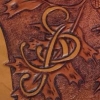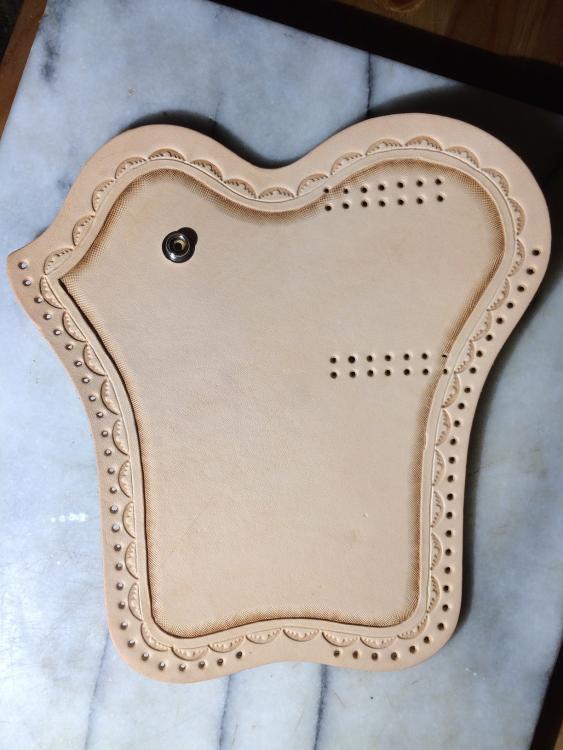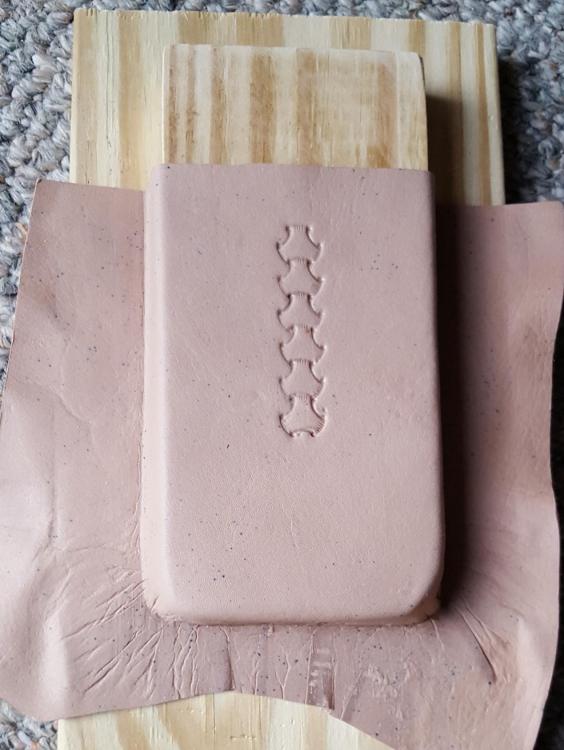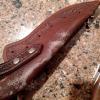Search the Community
Showing results for tags 'wet forming'.
-
I'm new to leather crafting and using a blog. If this should be posted elsewhere please advise. I tried running a search with no luck. I'm making leather greaves of veg tan cow hide. Stencils and cuts are done, tooling to be done soon. As it is relatively flat I will be wet forming it to fit around my leg so I wondered if I should: dye it first, then wet form? wet form, then dye? (I think this might be the way to go) or other suggestions? I'm using kelly green fiebings for the majority of it but I have a stag in the middle I would like to keep a lighter color maybe use the color block stuff and some hi light for the tooling recesses? Attached is the greave to be worked on and bracers I did that it will be matching. Thanks for any input!
- 6 replies
-
- wet forming
- leather dye
-
(and 2 more)
Tagged with:
-
Hello! I have a few questions about vegetable tanned goatskins- hopefully someone (or millions of you) might be able to answer. I have never handled vegetable tanned goatskins- is it as durable as cowhide? I'd like to it for a project that will require wet-forming- will it work the same as cowhide in this sense? Or will it shrink? I'm specifically wanting to make a "bush hat", similar to a cowboy hat but simpler. Thanks in advance!
- 19 replies
-
- goatskin
- vegetable tanned
-
(and 3 more)
Tagged with:
-
Hi Just found this excellent site. As someone wrote; "I've learned more here in one hour than days looking at Youtube". I,m a newbie in this area. Builed an Axe and a sheath a year ago and after that it become a hobby. But the more I do the more I realize that leather Craft isn't just a walk in the park. Respect to everyone here that master this nobel art. I'm going to make a cup/Dice cup/snuffbox. I read a post by "Tugadude" regading a dice cup made a long time ago and suddenly I got scared. But that's my goal... Question: How should I do to secure a flat base? If I use the original snuffbox (copy in Wood as well as the outside) as the inside mould, how should I avoid it don't become to big (it's supposed to fit a snuffbox without falling of. I will also do a lid that shall fit the outside the upper edge of the snuffbox. Of course, the dimensions are vital but if there are any tips how to do it right in the first place or if necessary expand/shrink one or both pieces, I would appriciate it very much. My last dilemma is when to tooling and when to forming. I've read alot about this question here but all are related to quite complicated items. All carving/tooling planed is on the top lid. An easy symbol made with a swivel and a bevel. Tanks in advance Best regardsBjorn
-
- mould
- wet forming
-
(and 2 more)
Tagged with:
-
This is the first project I've posted about...Tandy Bullseye holster kit for a 6 inch S&W 686...I've created several rejects trying to make my own pattern for this one, so I thought I'd try a different route. I'm hoping that through finishing a pre-cut pattern I'll see how things come together so I can move forward with my own holster patterns. Any advice will be appreciated... Below pic shows beveling and bordering done...stamping tri-weave tonight, and then wet molding tomorrow. I have read quite a bit about this process and decided to go the tooling then forming route to see how it works out. Also, if anyone can give me tips/best practices about posts, posting pics, etc., I'd really appreciate it...thank you!
- 12 replies
-
Hey y'all, So just a quick question before I spend money on trying. I'm hoping someone already has the answer. Is it possible to wet form exotics such as stingray, croc, gator, etc.? I really don't want to have to spend the cash to test this if I don't need to. Thank you. TwoFeathers
- 5 replies
-
- wet forming
- exotics
-
(and 1 more)
Tagged with:
-
Sorry for the short notice, but I've only just noticed this Firstly though, an explanation for non - British members. Any company that supplies the British Royal Family, their households, and their palaces can use that fact as part of their advertising and company profile, though they are expected to be suitably discrete and British about it. It can range from the mundane, like cleaning products to expensive items like exclusive clothing or jewellery. It's called 'by Royal Appointment' On Monday 13 th June, 8-30 pm on BBC4 there is a programme called 'Handmade: by Royal Appointment' It features John Lobb, a London shoemaker who still make shoes by traditional methods like hand carving a wooden last; wet forming the leather; then hand sewing I expect it can be found after that date for 28 days? on the BBC website, BBC iPlayer http://www.bbc.co.uk/iplayer http://www.johnlobb.com
-
The veg tanned leather, about 2mm thick, formed these blue specks after being clamped and sitting for only about 4 hours. This is my first wet forming, and also I used untreated wood which was intended for construction. Any idea if that was the cause? Could mold form that quickly on the leather? Thanks! Flexo
-

Wet Forming After Antique Finish
SLP posted a topic in Gun Holsters, Rifle Slings and Knife Sheathes
Please forgive me if I'm not doing this right. This is my first time on any forum. I am attempting to construct a holster with an antique finish. I am curious if wet forming will destroy the finish. I have tooled the leather (6-7oz) and plan to line with 3-4oz. I'm using eco flo gel antique. I don't want to do any intense moulding that will destroy the tooling, but I would like a snug fit. Do I just antique finish first and accept that some will be removed while wetting and forming? I plan to "seal" with super shene. Between the cement and super sheen I assume the water will take longer to penetrate sufficiently to form. Any help or tips would be greatly appreciated. Thanks.- 11 replies
-
- antique finish
- wet forming
-
(and 1 more)
Tagged with:
-
Hi All, Making a knife sheath, where you stitch the front and back together, and then the back goes up and over and folds down with a closure to connect to the front. I'd like to glue and then stitch pigskin into the sheath to line it 100%, but after than I want to wet the veg-tan leather through the pigskin so it can be wet formed by forcing the knife into the sheath to stretch it. So, is this an awesome idea or an awful one? Normally I'd just try it and learn from the experience but if the experience is "the project gets wrecked" I would be very sad. I'm confident I can wet the leather through the pigskin, but not confident I can wet it through the pigskin AND the layer of contact cement that'll be holding it on. I could glue the pigskin just at the stitching, but I worry it will pucker. Anybody have any ideas? This is mostly an aesthetic choice, but pragmatically I'm just trying to cover the back of the Line 24 snap to keep it from scratching the knife, and if worse comes to worst I can leave the grain of the leather exposed and just recess the snap. Thanks in advance! Dave
- 10 replies
-
- help
- wet forming
-
(and 1 more)
Tagged with:
-
I want to make some cases out of American Bison leather. MY QUESTION IS CIAN IT BE WET MOLDED?
-
Hello every one I'm new to the site and forums in general. Firstly i'd like to say thank you, as I found a lot of useful advice on this site when I was at university, helping me achieve a cracking grade and succeed. Secondly I want to mention that I am from the UK so apologise for using metric, because imperial is just beyond me. I am looking for some advice on how to press a form so that I can reliably reproduce the same shape. I was wondering if it would be possible to use ply with a hole in the same shape as the form + the thickness of the leather and use this to press the leather and former through? previously I have soaked leather in warmish water until the bubbles slow down, then layed the leather over my former and pinned it down into the shape. I hope i've made sense in this if i haven't please ask I've attched some pictures of the product, former and my original method. Thank you Dan
- 9 replies
-
- wet forming
- mould
-
(and 1 more)
Tagged with:
-
hi guys, i am looking for some advice/tips on how i can avoid getting what i assume are marks from dissolved minerals after wet forming, as shown in the image below. in my process i am tooling and dying before wet forming and after the piece dries i am always seeing these markings in varying degrees. in most cases after some buffing and application of a conditioner, or some neatsfoot oil, etc. the appearance is greatly reduced, often no longer really visible. but sometimes it's impossible to remove and obviously undesirable. just wondering if anyone can confirm for sure it's a result of hard water or is it for some other reason? thanks a lot, braden
-
Hello, I'm fairly new to leather working but have sewn all my life. I am doing OK but I still have a lot to learn. I have question about wet forming with veg tanned leather. I am making some wood chisel tip covers for a client, and was telling her how I make them. She is concerned that it doesn't get dry enough and her chisels will suffer for it. I thought they were very dry but her concerns are very valid, she spent a lot of money on her chisels. How do I know for certain they are dry and have no moisture left? Does the leather hold a lot of moisture? What is your experience with knife sheaths? What is the best procedure for drying? I was just leaving them sit on a shelf for a few days. Thank you very much Kat
- 6 replies
-
- veg tanned
- wet forming
-
(and 1 more)
Tagged with:
-
I'm very new to this but i have been wet forming knife sheaths and a few holsters. My question...Tool before or after wet forming. The trouble i'm having is once i have laid out pattern, tooled and stamped it when i wet form it the tooling and stamp fades. Any help would be greatly appreciated!
-
If you were making a number of moulded items could vacuum bagging be used to mould the leather over the forms. Personally I think it could work. Possibly the only problem I can foresee is the drying of the leather. I have vacuum bagging equipment that I use in fibreglassing. Cheers Frans
-
Howdy, So, made a few gun holsters, mostly wet formed stuff with simple stitching and some with tooling, but I am looking to do something a bit different now... I'd like to make a nice concealed carry holster for my 1911 and I want to include rattlesnake inlay... My question is, before I ruin everything, can I still wet form the holster once the snakeskin inlay has been done? Not a precise fit form, but more of a general forming just to allow the holster to hung the gun a bit and of course to form a extra clip holder. Any help would be greatly appreciated. Thanks, VM.
- 1 reply
-
- inlay
- wet forming
-
(and 1 more)
Tagged with:
-
Howdy, I'm a retired geezer who tries to learn new things. Where I live (Temple, TX), there are no classes available within a reasonable travel distance; and I've not found anyone around to be my mentor. I've got a ton of tools given to me by a brother in NC who has been at this for quite some time. I've bought the books and read them, but a lot of what I need to learn doesn't come easily from books. I bought a few pieces of leather hoping to be able to make a holster. I dove right in and cut several pieces. I cut them over-sized hoping to form the leather to the handgun itself (which I put in a plastic zip loc bag to keep dry). Apparently I didn't get the leather sufficiently pliable to form because boning with a deer antler or sharpie only yielded very uncrisp outlines. So, my first question is about how to wet form. I've found posts on casing which I understand to be a different process for a different result, ie, tooling. In trying to overcome my first failure to get a good crisp outline of the gun, I bought a 2' length of 4" PVC pipe and sealed one end with a cap and glue, placed the pieces in it, and poured in boiling water. I have no idea whether this is valid procedure or whether I've damaged the leather, but I used cold water and a long soak on my first attempts. The leather is of 2 types. One is what I'd estimate to be about 7-8 oz (which is probably too thick) and the other is a hard horsehide. Remember, I'm teaching myself from books and the web and using the trial and error method, mostly the latter. For my next attempt, I'm going to try to cut a pattern from poster board and make a pancake style holster from two pieces. I found a thread here yesterday, which I cannot find today and did not tag, that showed how one craftsman does this. The most significant thing I remember about his post was that he had the pistol canted in the holster so that the barrel pointed slightly rearward. I've tried searching for "cant" "canted" etc. but found no hits. I would really appreciate any pointers to tutorials or threads that will help me in this 2 areas. I want to master the molding and wet forming process as a first step, then proceed to pattern making for my specific pistols. If I can get those 2 steps accomplished, I think I can put something together and then post pics for critiques. Thank you for any help you can give me.
-
Hi! I desperately need some assistance. If I post this in the wrong place, I am sorry and I ask the post to be relocated to the right place. I have tried to make an Ipad sleeve, but it has not turned out how I imagined it. I sewed the two pieces together, but the leather gaped a lot in the opening with the Ipad inside. So clever me, I wetted the leather (with the Ipad inside) and put some books on top as weight. 1 hour later I removed the books and it looked nice. But the day after the opening looked funny as showed in the pictures. Shall I try to wet it all again, but leave it to dry for a longer period? Or am I taking the wrong path here? Hoping to hear from you! Best Regards Nicklas ps. after the wet forming the edge also separated like this:
- 5 replies
-
- help
- ipad sleeve
-
(and 1 more)
Tagged with:



















